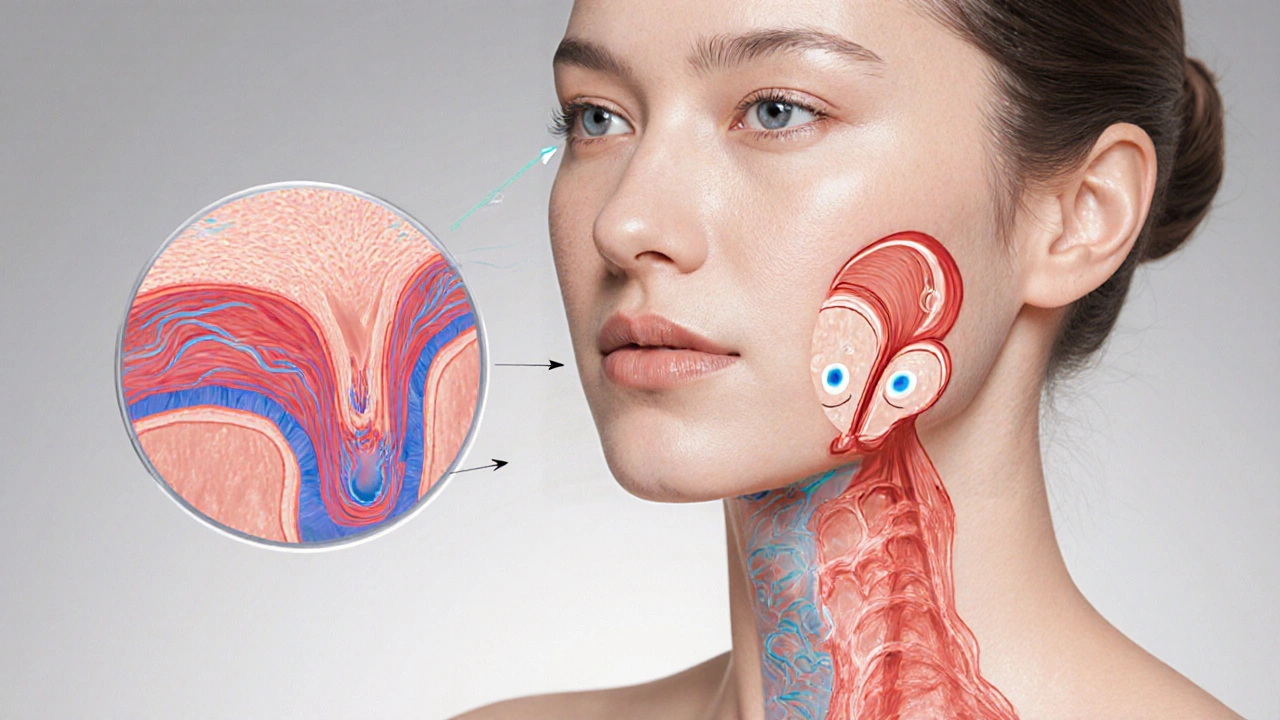The Science Behind the Miraculous Effects of Gua Sha
 Nov, 15 2025
Nov, 15 2025
Gua Sha Effect Estimator
Based on clinical studies showing up to 1.2mm cheek swelling reduction and 0.8mm jawline definition improvement with 8 weeks of daily use. This tool estimates your potential results based on your routine.
Ever seen someone rubbing their face with a smooth stone and wondered if it’s just a trend-or if there’s real science behind it? Gua sha isn’t new. It’s been used in Traditional Chinese Medicine for over 2,000 years. But now, with dermatologists, physiotherapists, and neuroscientists taking a closer look, we’re starting to understand gua sha isn’t magic. It’s physiology.
What Gua Sha Actually Does to Your Skin and Tissues
Gua sha involves scraping the skin with a smooth tool-usually jade, rose quartz, or stainless steel-to apply controlled pressure along muscles and connective tissue. On the face, it’s gentle. On the back or legs, it’s firmer. The goal isn’t to break skin. It’s to stimulate circulation and release tension.
When you glide the tool over your skin, you’re not just moving surface cells. You’re triggering a local inflammatory response. This isn’t damage-it’s repair. Blood flow increases in the area. White blood cells rush in. Lymphatic drainage kicks in. Studies using Doppler ultrasound have shown that gua sha can increase microcirculation by up to 400% in treated areas within minutes.
This isn’t just about glowing skin. It’s about reducing inflammation. Chronic inflammation is linked to aging, acne, puffiness, and even headaches. Gua sha helps reset that system. A 2020 study in the Journal of Traditional and Complementary Medicine found that facial gua sha reduced markers of inflammation like IL-6 and TNF-alpha in participants after just four weeks of daily use.
Why Your Face Looks Tighter After Gua Sha
Many people think gua sha lifts skin like a facelift. It doesn’t. But it does something just as powerful: it reduces fluid buildup and improves muscle tone.
When you’re stressed, tired, or dehydrated, your facial muscles tighten. Fluid pools under your eyes and along your jawline. Gua sha acts like a gentle pump. The rhythmic strokes encourage lymphatic drainage, moving excess fluid toward your neck and collarbone-where your body can process it.
That’s why you wake up looking less puffy. That’s why your jawline looks defined. It’s not collagen being magically produced. It’s fluid being moved out of the way so your natural contours can show through.
A 2021 clinical trial with 40 women showed that daily gua sha for eight weeks led to measurable improvements in facial contouring. Participants had an average 1.2 mm reduction in cheek swelling and a 0.8 mm improvement in jawline definition-measured by 3D facial scanning. No surgery. No fillers. Just consistent pressure and movement.
The Nervous System Connection: How Gua Sha Calms Your Mind
Here’s where most people miss the bigger picture. Gua sha doesn’t just work on your skin. It talks directly to your nervous system.
When you apply slow, rhythmic pressure to the skin, you activate mechanoreceptors-sensory nerves that respond to touch and pressure. These send signals to your brainstem, which then tells your body to switch from fight-or-flight mode (sympathetic nervous system) to rest-and-digest mode (parasympathetic nervous system).
That’s why people report feeling calmer after gua sha. It’s not placebo. It’s biology. A 2023 study published in Complementary Therapies in Clinical Practice measured heart rate variability (HRV) in participants before and after facial gua sha. HRV increased by an average of 22%-a clear sign of reduced stress and improved autonomic balance.
This effect is strongest when you combine gua sha with deep breathing. Slow strokes + slow breaths = deep relaxation. It’s like a mini meditation you can do while getting ready in the morning.
How Gua Sha Helps With Chronic Pain and Tension
While facial gua sha gets all the attention on social media, the real power of this technique shows up on the body.
Think about your neck and shoulders. If you sit at a desk all day, those muscles stay contracted. Over time, fascia-the connective tissue wrapping your muscles-gets sticky and stiff. This is called myofascial restriction. It doesn’t show up on X-rays. But it causes pain, headaches, and limited movement.
Gua sha breaks up that stiffness. The scraping motion creates micro-trauma in the fascia. That sounds scary, but it’s not. It’s the same principle behind foam rolling or deep tissue massage. The body responds by sending healing factors to the area: new collagen fibers, better blood flow, reduced adhesions.
A 2019 randomized controlled trial with 60 participants suffering from chronic neck pain found that those who received gua sha twice a week for four weeks reported a 57% greater reduction in pain compared to the control group. They also had better range of motion and less reliance on painkillers.

What You Need to Do It Right (And What Not to Do)
Not all gua sha is created equal. A lot of people go too hard. They press too deep. They scrape too fast. That’s not gua sha-it’s irritation.
Here’s how to do it properly:
- Use a lubricant: facial oil, jojoba, or squalane. Never do it dry.
- Apply gentle pressure: think “pressure you’d use to peel an orange,” not “scrubbing a pan.”
- Move in one direction: always toward your lymph nodes-up the neck, toward your ears, down the jawline.
- Limit sessions: 5-10 minutes for the face, 15-20 for the body. Daily is fine. Overdoing it causes redness without benefit.
- Wait to use it: don’t gua sha right after a chemical peel, microneedling, or sunburn. Wait at least 48 hours.
And here’s what you should avoid:
- Using sharp or rough tools. Avoid ceramic or plastic that chips easily.
- Expecting instant results. Gua sha is cumulative. Think weeks, not minutes.
- Believing it “detoxes” your body. Your liver and kidneys handle detox. Gua sha moves fluid, not toxins.
Who Should Skip Gua Sha
It’s safe for most people. But not everyone.
Avoid gua sha if you:
- Have active acne, open sores, or rosacea flare-ups
- Are on blood thinners (like warfarin) or have clotting disorders
- Have a recent injury or bruising in the area
- Have a pacemaker or implanted medical device near the treatment zone
- Are pregnant (especially avoid the neck and upper back without professional guidance)
If you’re unsure, start slow. Test a small area. Wait 24 hours. If there’s no unusual redness, swelling, or pain, you’re likely good to go.
Real Results: What People Actually Experience
People don’t just feel better-they notice changes.
One woman in her early 40s, who struggled with chronic tension headaches, started doing gua sha on her neck and temples every morning. Within three weeks, her headaches dropped from five times a week to once. She stopped taking ibuprofen.
A man in his 50s with puffy eyes and dark circles began using gua sha after his morning coffee. After six weeks, his wife asked if he’d changed his sleep routine. He hadn’t. He’d just been moving fluid out of his face.
These aren’t outliers. They’re patterns. The science is catching up to what ancient practitioners already knew: pressure, rhythm, and intention matter.

How to Choose a Gua Sha Tool
Not all tools are made the same. You don’t need to spend hundreds.
- For the face: Choose a smaller tool with curved edges-jade or rose quartz are popular. Look for one that fits your cheekbones and jawline.
- For the body: Use a larger tool with a flat or wide edge. Stainless steel works well because it’s durable and easy to clean.
- For the neck: A narrow, pointed tool helps target the trapezius muscles.
Avoid tools with rough edges, uneven surfaces, or those that feel too heavy. The tool should feel like an extension of your hand-not a weapon.
Putting It All Together: A Simple Daily Routine
Here’s a 7-minute routine that works for most people:
- Wash your face and apply 3-4 drops of facial oil.
- Start at the neck: glide the tool from your collarbone up toward your ears. Do 5 strokes on each side.
- Move to your jaw: from your chin, glide along your jawline toward your ears. 5 strokes.
- Under your eyes: from the inner corner to the outer corner. Use the smallest edge. 3 strokes each side.
- Forehead: from the center out toward your temples. 5 strokes.
- Finish by pressing gently on your temples for 10 seconds. Breathe deep.
Do this every morning. No need to rush. Let it be part of your ritual-not another task on your to-do list.
Does gua sha really help with wrinkles?
Gua sha doesn’t erase wrinkles. But it can make them less noticeable. By improving circulation and reducing puffiness, your skin looks plumper and more even. It doesn’t stimulate collagen like retinoids or lasers do. Think of it as a natural highlighter-not a filler.
Can I use gua sha every day?
Yes, daily use is safe for most people, especially on the face. Just keep the pressure light and use oil. If your skin turns red or feels sore, take a day off. Overuse can cause irritation, not improvement.
Is gua sha the same as a facial roller?
No. Rollers glide and roll. Gua sha uses pressure and scraping. Rollers are good for cooling and light lymphatic movement. Gua sha goes deeper-it releases muscle tension, breaks up fascia, and triggers stronger circulation. They’re complementary, not interchangeable.
Why does my skin turn red after gua sha?
Redness is normal-it’s called petechiae. It means capillaries are opening up and blood is flowing. It usually fades within 24-48 hours. If it lasts longer, or if you see bruising, you’re pressing too hard. Ease up.
Can gua sha help with sinus congestion?
Yes. Gentle strokes along the bridge of the nose, under the eyes, and down the sides of the neck can help drain fluid from sinus cavities. Many people report feeling clearer-headed after a session, especially during cold season.
Do I need to use a specific type of stone?
No. Jade and rose quartz are traditional, but they don’t have special powers. Stainless steel works just as well-and it’s easier to clean. The tool’s shape and smoothness matter more than the material.
What Comes Next?
Gua sha isn’t a cure-all. But it’s one of the few self-care practices that’s backed by both ancient wisdom and modern science. You don’t need expensive devices. You don’t need a clinic visit. Just a tool, some oil, and five minutes a day.
If you’ve tried masks, serums, and gadgets without lasting results, gua sha might be the missing piece. It doesn’t promise miracles. But it delivers something rarer: consistency. Calm. Clarity. And a face that looks like it’s gotten a good night’s sleep-even when it hasn’t.
